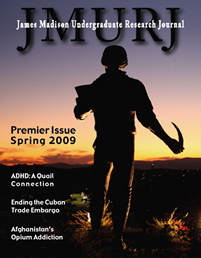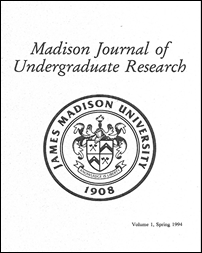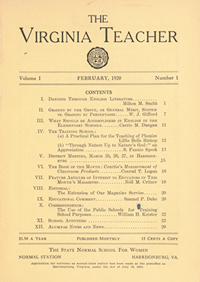Publishing History
A James Madison Undergraduate Research Journal
News
An undergraduate research journal at James Madison University is not a novel concept.
The James Madison Undergraduate Research Journal (2013–present) builds on the work of 2007–2009 JMURJ student editors. In the mid-1990s, the Madison Journal of Undergraduate Research published four volumes of undergraduate research. And back when JMU was the State Normal School for Women at Harrisonburg (1914–24), the State Teachers College at Harrisonburg (1924–38), and Madison College (starting in 1938), an in-house publication titled The Virginia Teacher regularly published undergraduate reviews and articles.
 |
JMU undergraduate Physics majors Casey Boutwell and Laurence Lewis founded the James Madison Undergraduate Research Journal in 2007, envisioning a JMU undergraduate journal that could foster "a community of ambitious, open-minded student-researchers" by encouraging the multidisciplinary collaboration, peer review, and publication opportunities that are at the heart of professional academia.
They visited classes, talked to professors, enlisted Dr. Kurt Schick, then the Director of the University Writing Center, as a faculty adviser, and spent the next year defining the journal and establishing a campus presence.
The blueprint Boutwell and Lewis developed for JMURJ was "simple and easily reproducible":
We developed a preliminary model of how we imagined an undergraduate research journal would operate. We determined which features were important to us (like multiple disciplines, student administration, and peer review), and what characteristics we wanted to avoid (too much university oversight and overly constraining our definition of research).
In Spring 2009, a team of editors led by Sierra Stanczyk and Alex Sharp VIII published the first issue of JMURJ.
 |
JMU's College of Letters and Sciences published four volumes of the Madison Journal of Undergraduate Research between 1994 and 1997. Student editors participating in two 300-level English classes published "research manuscripts written by JMU undergraduates from all disciplines within the university" with a goal of promoting "the importance of researching and writing throughout academia and the professions."
Print volumes of MJUR are available in the JMU Libraries Special Collections Reading Room. We offer the first pages of Volume 1 and the preface from Volume 2 here.
The Virginia Teacher, also available in the JMU Libraries Special Collections Reading Room, was one of JMU’s regular early publications (along with The Breeze and The Normal Bulletin). While early volumes featured articles by faculty members from the State Normal School for Women at Harrisonburg (1914–1924) and the State Teachers College at Harrisonburg (1924–1938), as well as by local school teachers, the journal increasingly included scholarship by professors at other state and regional colleges.
|
|
The Virginia Teacher also regularly published student articles throughout its twenty-year run. Nell M. Critzer's review titled “Feature Articles of Interest to Educators in this Month’s Magazines” appeared in Volume 1, Issue 1 (1920). Critzer—author of several Virginia Teacher pieces—mentions a fellow by the name of Albert Einstein, who was apparently doing some good work. Her piece in Issue 1 of The Virginia Teacher appears just before an "Educational Comment" from Samuel Page Duke (still in the first of his thirty years as the school's second president).
Clare Harnsberger, "awarded the Dingledine Prize for the best essay submitted by this year’s graduating class," was also published in The Viriginia Teacher in 1920. Harnsberger was the second of many Dingledine scholarship recipients, as Raymond Carlyle Dingledine, Sr., and Agness Dingledine began awarding a $10 prize for the best senior essay in 1919. Harnsberger's essay, titled “Sonnet Forms,” appeared in Volume 1, Issue 6 of The Virginia Teacher.

